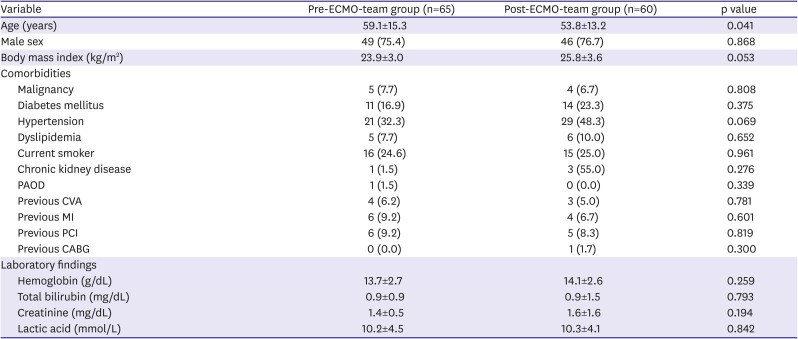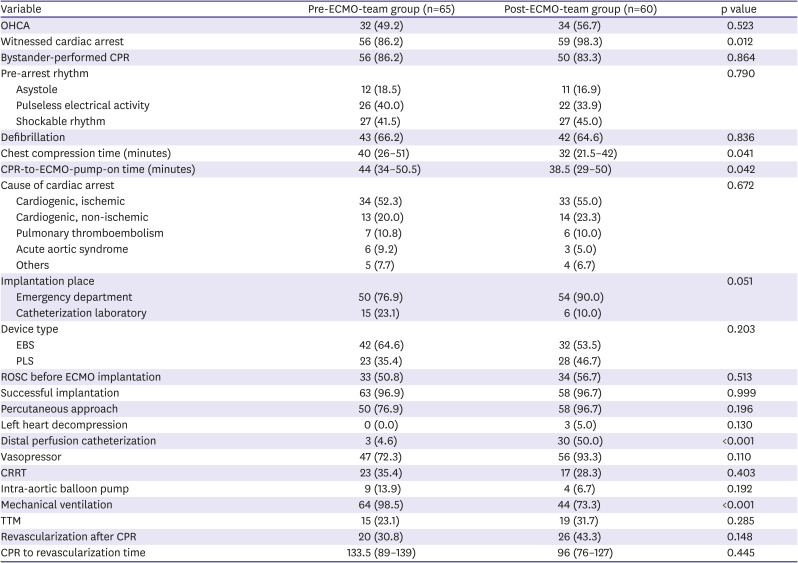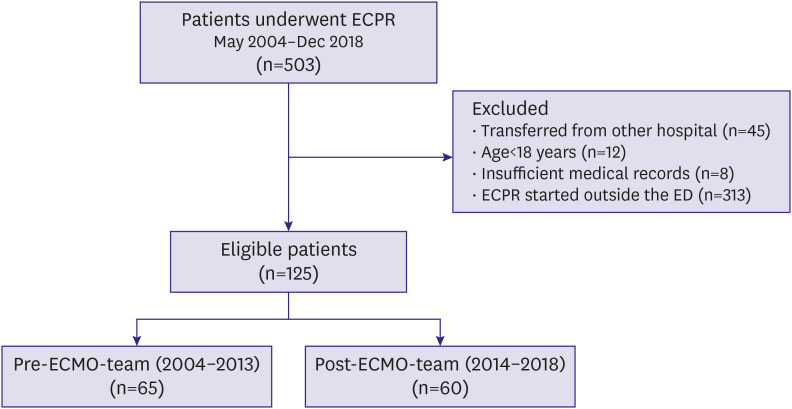1. Peberdy MA, Kaye W, Ornato JP, et al. Cardiopulmonary resuscitation of adults in the hospital: a report of 14720 cardiac arrests from the National Registry of Cardiopulmonary Resuscitation. Resuscitation. 2003; 58:297–308. PMID:
12969608.

2. Bloom HL, Shukrullah I, Cuellar JR, Lloyd MS, Dudley SC Jr, Zafari AM. Long-term survival after successful inhospital cardiac arrest resuscitation. Am Heart J. 2007; 153:831–836. PMID:
17452161.

3. Ehlenbach WJ, Barnato AE, Curtis JR, et al. Epidemiologic study of in-hospital cardiopulmonary resuscitation in the elderly. N Engl J Med. 2009; 361:22–31. PMID:
19571280.

4. Hajbaghery MA, Mousavi G, Akbari H. Factors influencing survival after in-hospital cardiopulmonary resuscitation. Resuscitation. 2005; 66:317–321. PMID:
16081201.

5. Mattox KL, Beall AC Jr. Resuscitation of the moribund patient using portable cardiopulmonary bypass. Ann Thorac Surg. 1976; 22:436–442. PMID:
999368.

6. Chen YS, Lin JW, Yu HY, et al. Cardiopulmonary resuscitation with assisted extracorporeal life-support versus conventional cardiopulmonary resuscitation in adults with in-hospital cardiac arrest: an observational study and propensity analysis. Lancet. 2008; 372:554–561. PMID:
18603291.

7. Richardson AS, Schmidt M, Bailey M, Pellegrino VA, Rycus PT, Pilcher DV. ECMO cardio-pulmonary resuscitation (ECPR), trends in survival from an international multicentre cohort study over 12-years. Resuscitation. 2017; 112:34–40. PMID:
27993632.

8. McCarthy FH, McDermott KM, Kini V, et al. Trends in U.S. extracorporeal membrane oxygenation use and outcomes: 2002–2012. Semin Thorac Cardiovasc Surg. 2015; 27:81–88. PMID:
26686427.

9. Paden ML, Rycus PT, Thiagarajan RR; ELSO Registry. Update and outcomes in extracorporeal life support. Semin Perinatol. 2014; 38:65–70. PMID:
24580761.

10. Tung YC, Chang GM, Chen YH. Associations of physician volume and weekend admissions with ischemic stroke outcome in Taiwan: a nationwide population-based study. Med Care. 2009; 47:1018–1025. PMID:
19648828.
11. Abrams D, Garan AR, Abdelbary A, et al. Position paper for the organization of ECMO programs for cardiac failure in adults. Intensive Care Med. 2018; 44:717–729. PMID:
29450594.

12. Hong D, Choi KH, Cho YH, et al. Multidisciplinary team approach in acute myocardial infarction patients undergoing veno-arterial extracorporeal membrane oxygenation. Ann Intensive Care. 2020; 10:83. PMID:
32548658.

13. Swanson RW. Recommended guidelines for uniform reporting of data on out-of-hospital cardiac arrests: the “Utstein style”. CMAJ. 1991; 145:407–410. PMID:
1878823.
14. D'Arrigo S, Cacciola S, Dennis M, et al. Predictors of favourable outcome after in-hospital cardiac arrest treated with extracorporeal cardiopulmonary resuscitation: A systematic review and meta-analysis. Resuscitation. 2017; 121:62–70. PMID:
29020604.
15. Ryu JA, Cho YH, Sung K, et al. Predictors of neurological outcomes after successful extracorporeal cardiopulmonary resuscitation. BMC Anesthesiol. 2015; 15:26. PMID:
25774089.

16. Yu HY, Wang CH, Chi NH, et al. Effect of interplay between age and low-flow duration on neurologic outcomes of extracorporeal cardiopulmonary resuscitation. Intensive Care Med. 2019; 45:44–54. PMID:
30547322.

17. Langer T, Santini A, Bottino N, et al. “Awake” extracorporeal membrane oxygenation (ECMO): pathophysiology, technical considerations, and clinical pioneering. Crit Care. 2016; 20:150. PMID:
27357690.

18. Kass M, Moon M, Vo M, Singal R, Ravandi A. Awake extracorporeal membrane oxygenation for very high-risk coronary angioplasty. Can J Cardiol. 2015; 31:227.e11–227.e13.

19. Liu S, Ravandi A, Kass M, Elbarouni B. A case of awake percutaneous extracorporeal membrane oxygenation for high-risk percutaneous coronary intervention. Cureus. 2017; 9:e1191. PMID:
28553569.

20. Kacer J, Lindovska M, Surovcik R, et al. Refractory cardiogenic shock due to extensive anterior STEMI with covered left ventricular free wall rupture treated with awake VA-ECMO and LVAD as a double bridge to heart transplantation - collaboration of three cardiac centres. Biomed Pap Med Fac Univ Palacky Olomouc Czech Repub. 2015; 159:681–687. PMID:
26498212.

21. Youn T, Kim D, Park TK, et al. Clinical outcomes of early extubation strategy in patients undergoing extracorporeal membrane oxygenation as a bridge to heart transplantation. J Korean Med Sci. 2020; 35:e346. PMID:
33140587.

22. Park JH, Kim YJ, Ro YS, Kim S, Cha WC, Shin SD. The effect of transport time interval on neurological recovery after out-of-hospital cardiac arrest in patients without a prehospital return of spontaneous circulation. J Korean Med Sci. 2019; 34:e73. PMID:
30863269.

23. Kim SJ, Jung JS, Park JH, Park JS, Hong YS, Lee SW. An optimal transition time to extracorporeal cardiopulmonary resuscitation for predicting good neurological outcome in patients with out-of-hospital cardiac arrest: a propensity-matched study. Crit Care. 2014; 18:535. PMID:
25255842.

24. Nagao K, Nonogi H, Yonemoto N, et al. Duration of prehospital resuscitation efforts after out-of-hospital cardiac arrest. Circulation. 2016; 133:1386–1396. PMID:
26920493.

25. Jo IJ, Shin TG, Sim MS, et al. Outcome of in-hospital adult cardiopulmonary resuscitation assisted with portable auto-priming percutaneous cardiopulmonary support. Int J Cardiol. 2011; 151:12–17. PMID:
20471704.

26. Fagnoul D, Combes A, De Backer D. Extracorporeal cardiopulmonary resuscitation. Curr Opin Crit Care. 2014; 20:259–265. PMID:
24785674.

27. Soar J, Nolan JP, Böttiger BW, et al. European Resuscitation Council Guidelines for Resuscitation 2015: Section 3. Adult advanced life support. Resuscitation. 2015; 95:100–147. PMID:
26477701.
28. Maclaren G, Pasquali SK, Dalton HJ. Volume-outcome relationships in extracorporeal membrane oxygenation: is bigger really better? Crit Care Med. 2014; 42:726–727. PMID:
24534958.
29. Thiagarajan RR, Barbaro RP, Rycus PT, et al. Extracorporeal Life Support Organization Registry International Report 2016. ASAIO J. 2017; 63:60–67. PMID:
27984321.










 PDF
PDF Citation
Citation Print
Print




 XML Download
XML Download